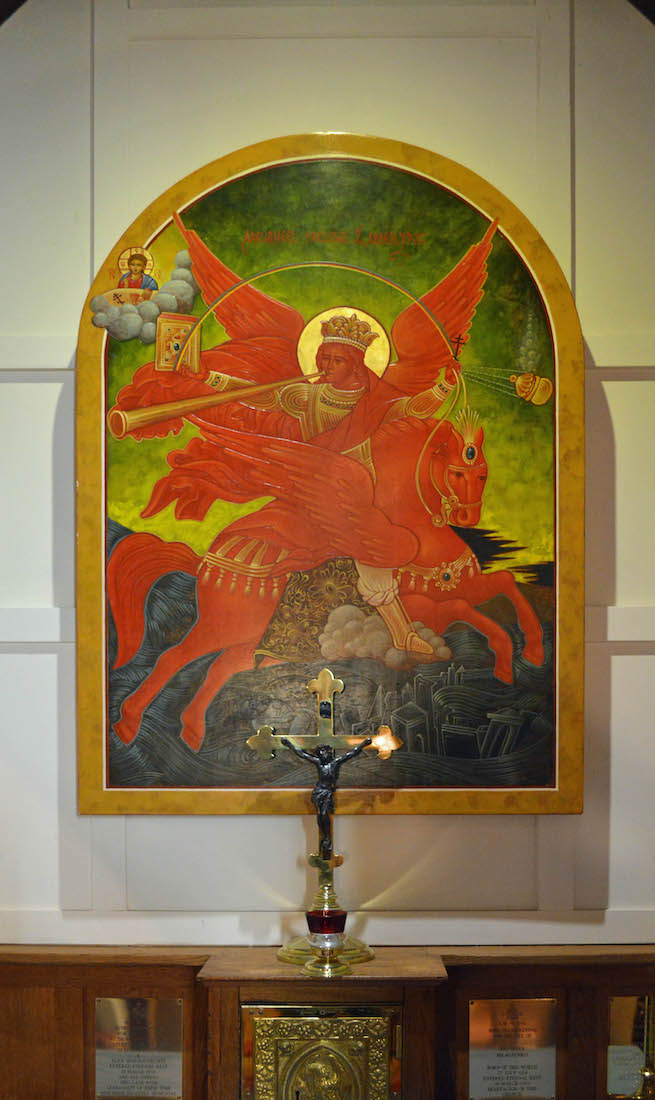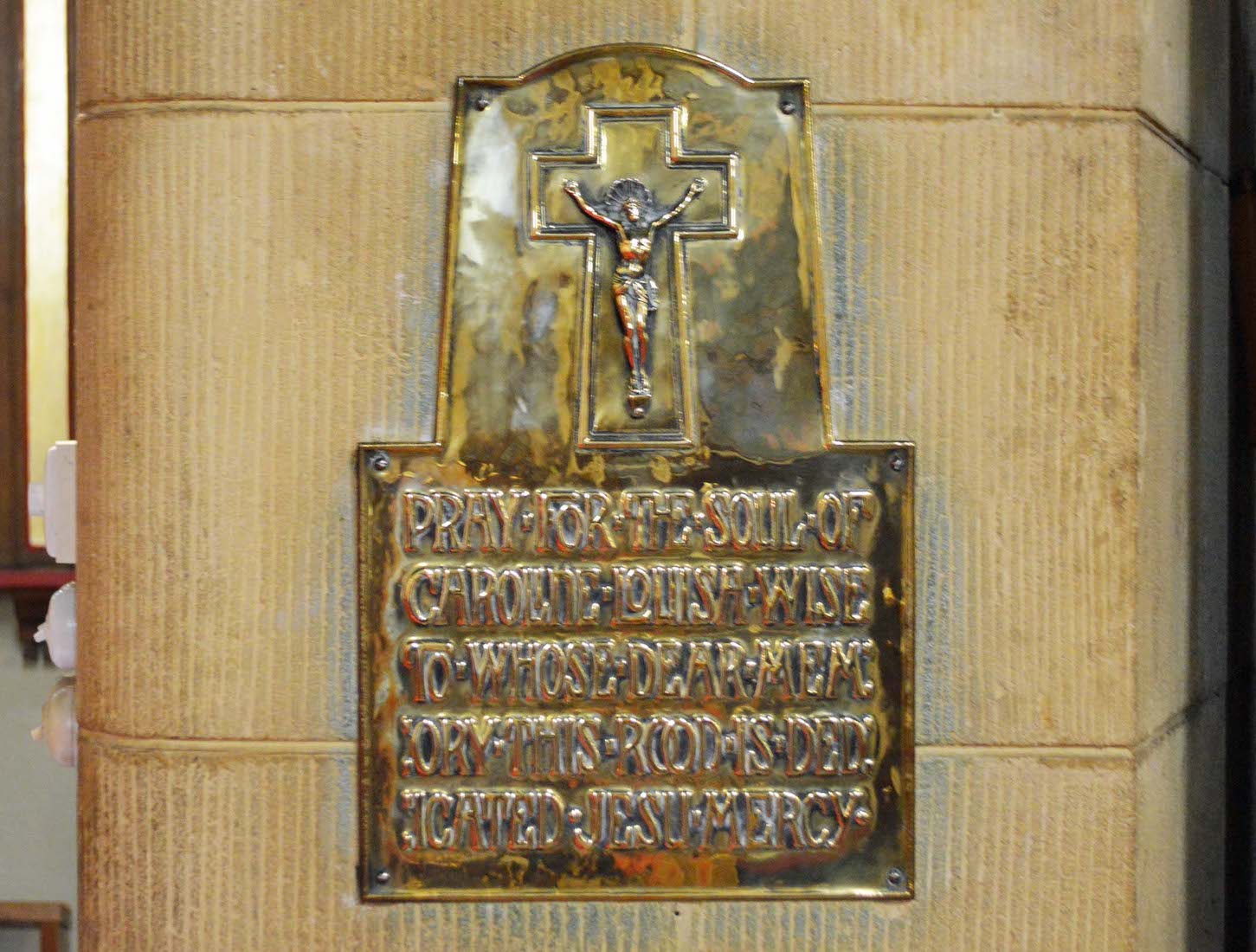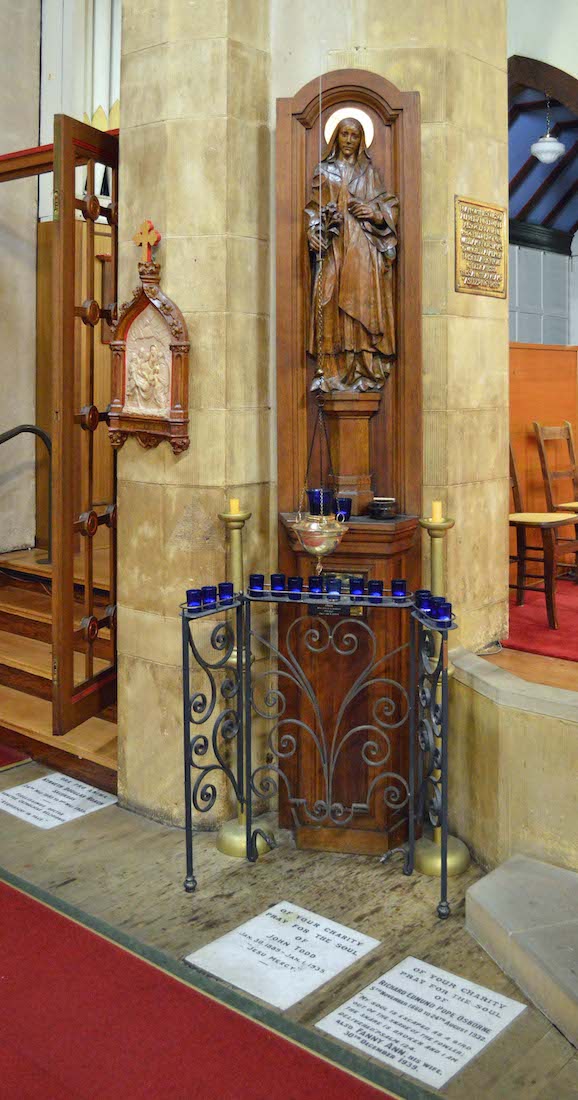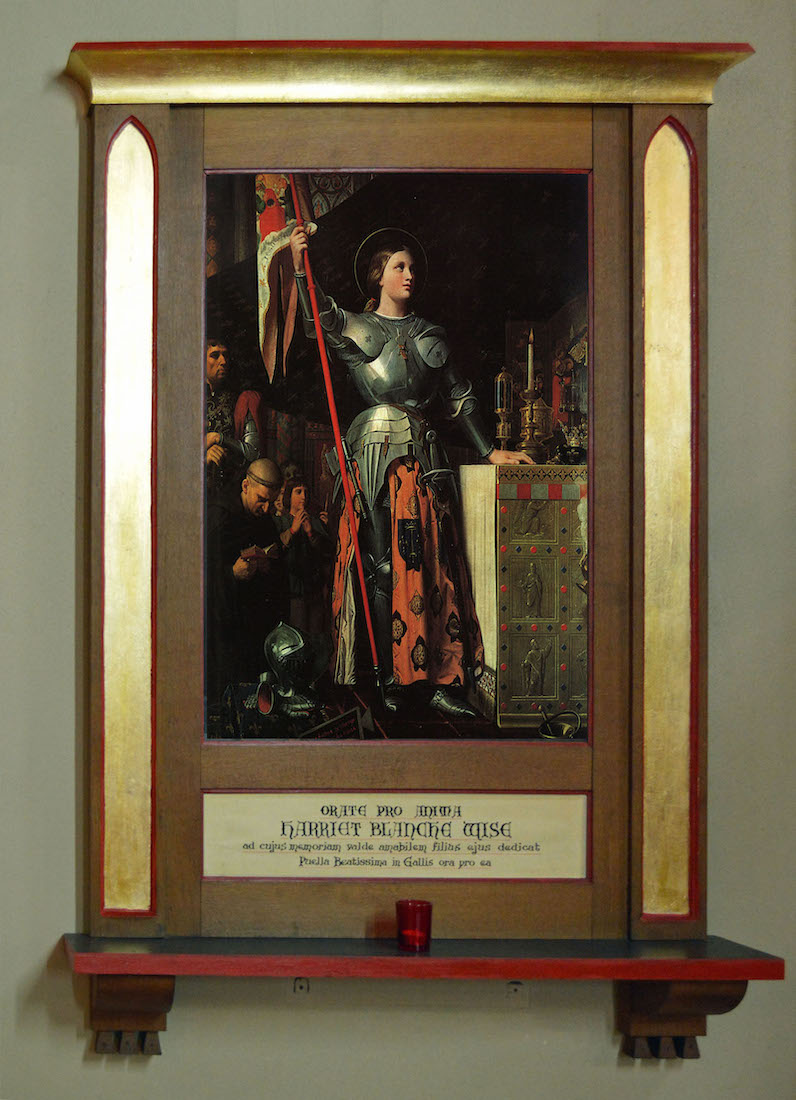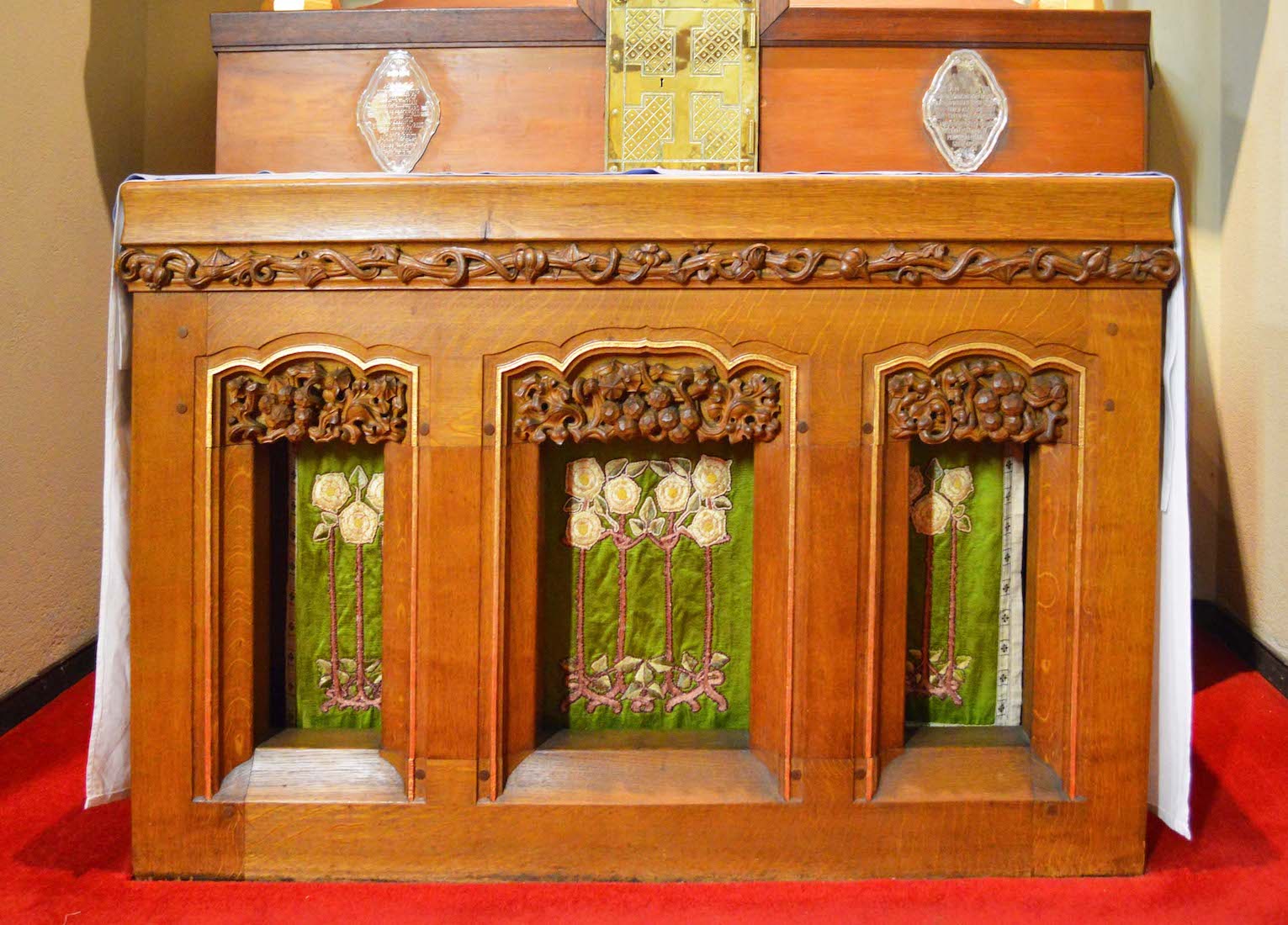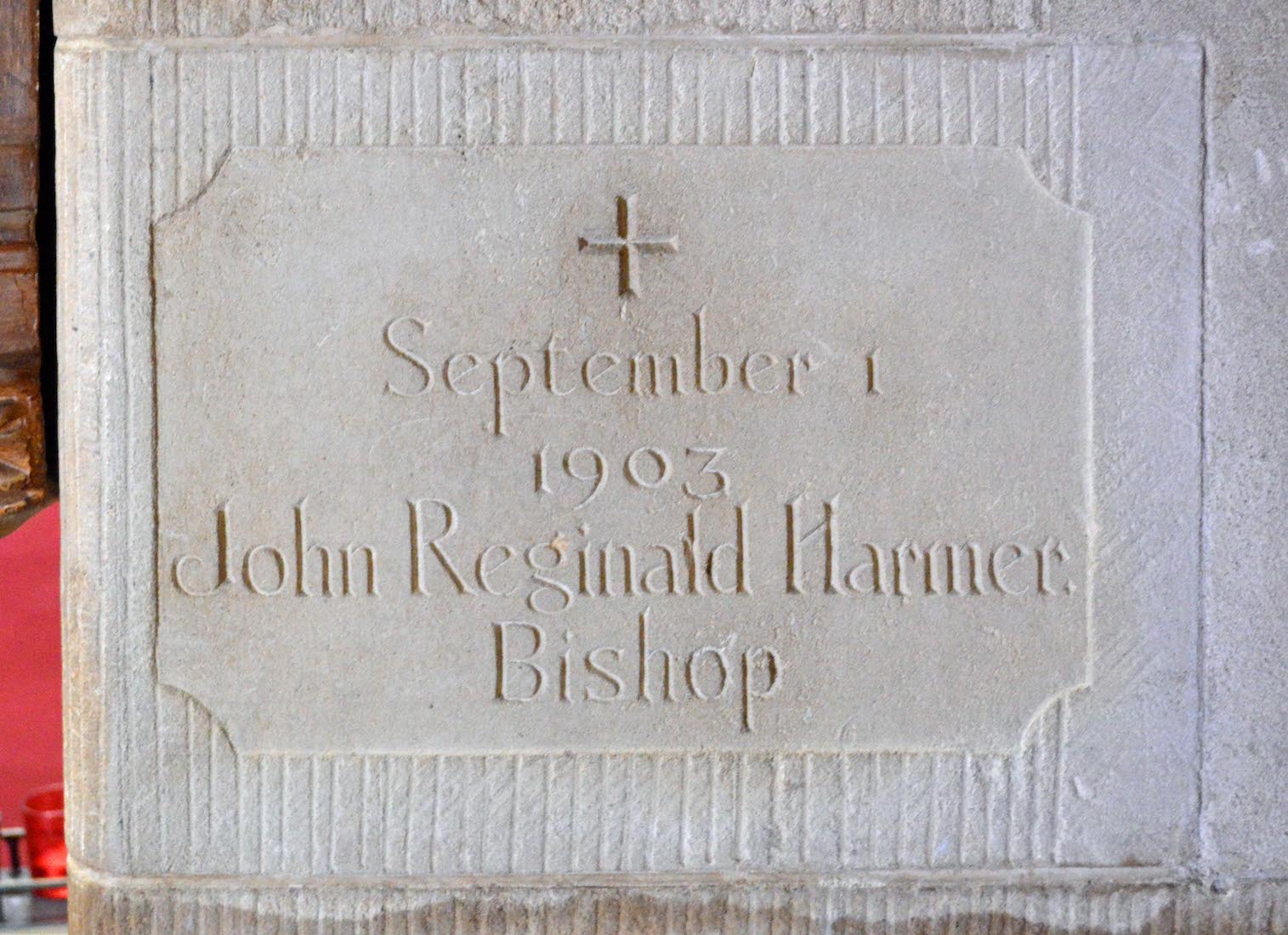19. PULPIT
Father Wise collected money for the pulpit from friends in England in 1905. It was designed by Lyon. On the back wall of the pulpit is the fine Oberammergau crucifix made by Josef Meyer. Two wooden figures stand alongside the pulpit. At left is St Anthony of Padua. He is holding a book, highlighting his reputation as a well known preacher and teacher in the 13th Century. At right stands St Francis of Assisi. This 12th Century saint with a love of nature is shown with two small birds. The carving is the work of Keith Oliphant, in memory of his mother.
20. FLOOR PLAQUES AND LECTERN
20. Just behind the pulpit is an interesting revolving lectern. This was designed so that two Bibles open at different readings can be placed on it simultaneously, ready for use. It was designed by Lyon and made at St Sidwell's Studio Exeter in 1904. Unusually, there are a great number of memorial slabs in the floor here. There is a great range of early dates, and many claim to have ashes buried beneath.
21. ORGAN




By the door to the flower vestry we find a bell in memory of Colin Holmes, organist for 40 years. The bell-pull was obtained from Footrope Knots, Members of the International Guild of Knot Tyers, Ipswich UK. The ‘Dragon’ bracket for the bell was made by local blacksmith Frederik Frank. Following East we come to the organ with an accompanying plaque, and a memorial plate for organist Colin Holmes. The original organ was a two manual instrument with pedals and thirteen speaking stops designed by Edward F. Conrath of London, and built by Al Noterman, London. Considerable work and enlargement has taken place since.
22. ORGAN PRINTS



Below the organ pipes there are thee paintings by Fra (Brother) Angelico. From left these are ‘The Annunciation’, ‘The Transfiguration’, and ‘Christ as Pilgrim’. In the first painting, a cloister of Fra Angelico’s convent of St Mark is shown, along with a fellow Dominican (St Peter the Martyr). The central painting is a copy of a fresco at St Marco in Florence. The Gospels tell us that after his resurrection Jesus appeared to two disciples on the road to Emmaus, and the painting at right recreates this appearance to two Dominican Brothers.
23. COLUMBARIUM
As we make our way to the Chapel of St Michael and St George we pass several items. Most noticeable is the Columbarium where the ashes of the departed are laid to rest. This was built in memory of Rosetta Ann Down in May 1945. Nearby are plaques remembering Leslie John Halifax, and Thomas Ambrose Dawe and his family. At right is a credence shelf backed with a carved wooden panel. The carved lettering reads: Sinute parvelos venire ad me or ‘Suffer the little children to come to me’.
24. SS MICHAEL & GEORGE CHAPEL
We come to the little Chapel of St Michael and St George. A picture of St Michael appears in the left window, and a less flattering depiction of St George is at right. Above the altar hangs an icon of St Michael of the Apocalypse. This icon was commissioned from Fr Damian Higgins in the USA in memory of generous benefactor, Mrs Antonia Bilaczenko. There is a crucifix and a tabernacle, the door of which is marked with the symbol of a pelican surrounded by four cherubs and grape-vine decoration. On the face of the altar is a gold depiction of Leonardo da Vinci’s ‘Last Supper’, showing Christ and his disciples gathering together.
25. SANCTUARY
Moving back into the body of the Church we face the sanctuary. A wooden figure of St Mary stands by the column at left, and a figure of St George at right. Above each is a fearsome dragon from which a small light hangs. Above us at ceiling height is the rood (cross). Attached to the right hand column is a plaque with a dedication of the rood to Caroline Louise Wise. Caroline was the much loved wife of Rev Percy Wise. She died of fever in 1900 while travelling by ship near Manilla. The rood was carved by Nathaniel Hitch in Exeter. The cross is about 8 ft. high, and the figure upon it is about 5 ft., whilst the figures of St Mary and St John are in proportion.
26. CHANCEL
On either side of the chancel stand these wonderful carved figures of St Mary and of St George, both designed by Lyon and carved by Hitch in 1912. The figure of Our Lady was in memory of Muriel Hill; the figure of St George was given in memory of Frank Arthur Thorns. Above each figure is an impressive metal dragon bracket, designed to hold the lamps before the shrines of Our Lady and St George They were designed to facilitate the lowering and raising of the lamps and were made by Frederick Franks, blacksmith, in 2013. Next to the St Mary figure is a plaque relating to the donation of some unidentified sanctuary lamp.
27. ALTAR, CROSS, CROWN
This High Altar was dedicated in 1956. Some relics of St Cuthbert have been inserted (there is a plaque on Altar). It is assumed that the relics were collected by Father Wise on one of his overseas holidays. The tabernacle was given many years ago in memory of a devout pioneer priest of the Catholic movement in this Diocese, John Hussey. The High Altar ornaments are the gift of Mrs Bonnin, in memory of her husband Paul Frederic Bonnin. High above the altar are the Cross and Crown installed in 1970 and designed by Voitre Marek, a sculptor in metal. They are made of copper with parts gold-plated and parts burnished.
28. SANCTUARY
On the North wall of the sanctuary is a painting called ‘The Holy Family’, painted after the style of Carlo Maratta. On the South side is a low table with a small book holder and bell. Close to this is an aumbry niche, apparently no longer used for its original purpose. Beneath this is a brass plaque recording the gift of a high altar reredos in memory of John and Margaret Beck. Close by is a painting by Jérôme-Dai Libri, given in memory of Priest John Pitcher and his wife Mary. The painting shows the Virgin and Child with Saints Lorenzo Giustiniani and Zeno.
29. TO THE LADY CHAPEL
Standing back in the chancel, we now look South across towards the Lady Chapel. Facing us are a window and more paintings to be investigated. On the arch support is a cross shaped plaque in memory of Paul Frederic Bonnin and a dedication of the ornaments on the altar. Opposite is an Honours Roll listing the names of those from this Parish who gave their lives in the Great War. The screen was blessed on Anzac Day 1922. The stained glass window depicting Our Lady with Christ Child was given in memory of Alfred Simms. The smaller painting is an oil painting of Mater Dolorosa, copy of a masterpiece painted in 1879 and bearing the signature ‘R.M. Solomon’ – a gift from the children of St Georges.
30. PAINTINGS
There are two further interesting paintings on the facing wall. The painting on left is described in the Church archives as a pseudo tapestry called ‘Virgin and Child’ painted after the style of Madonna Uliva Speciosa (Barbarino). It is in memory of Rose Mabel Hill. The painting on the right depicts St Joan of Arc before the Altar at Rheims. It is a copy from Ingres (1780-1867), a leader of the classical tradition of French painting, and a memorial to Harriet Blanche Wise.
31. LADY CHAPEL
The Lady Chapel is in honour of Mary, who is also referred to as ‘Our Lady’. The fine carving behind the altar depicts the archangel Gabriel appearing to Mary. This is a copy of Fra Lippi's picture of The Annunciation. The gilt-mounted crucifix icon is worked in authentic Russian tradition. The altar was the gift of Father Wise and was installed in 1904.
32. NEAR THE LADY CHAPEL
On the North side of the entry to the Lady Chapel is this painting by Raphael of the ‘Virgin and Child with another child’, sometimes referred to as ‘Madonna of the Chair’. It was painted in 1516, and given in memorial to Charles John Everard and Charlotte Everard. Opposite is an Icon of the Virgin of Kazan. It is by a Russian priest, and worked in the authentic Russian tradition. The frame is silver gilt. It was given in 1988 in memory of Herbert Frank Willoughby.















